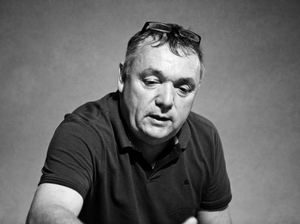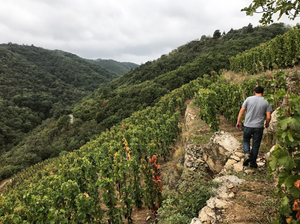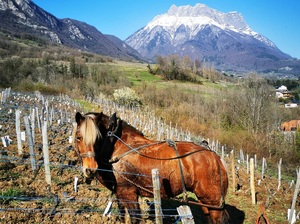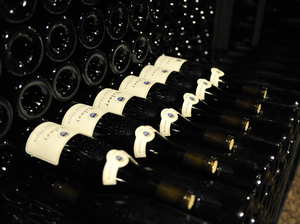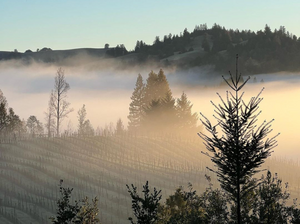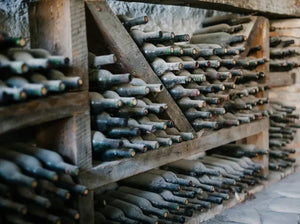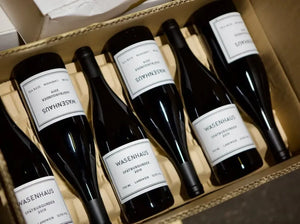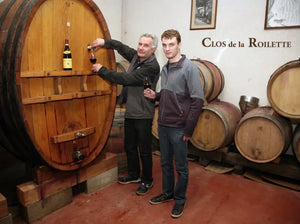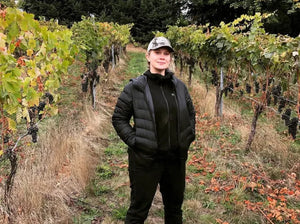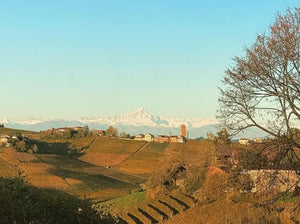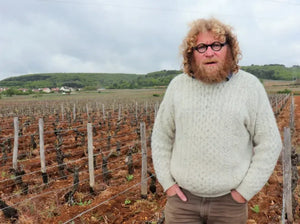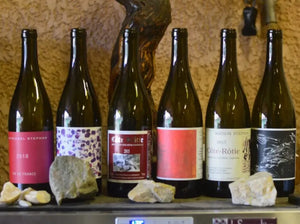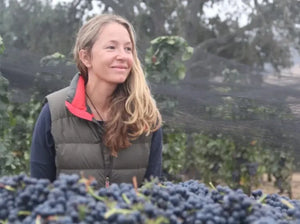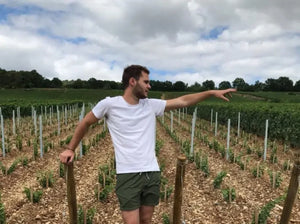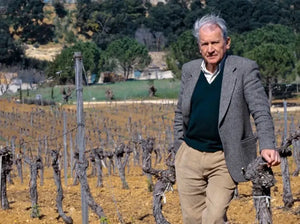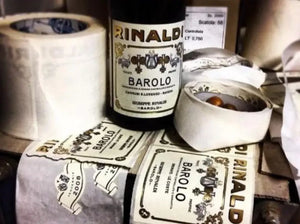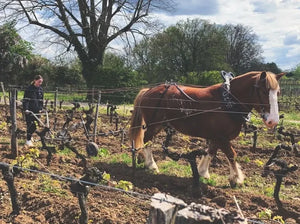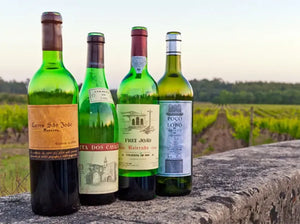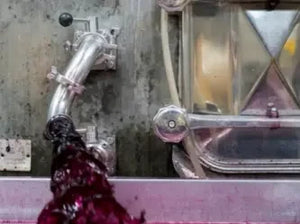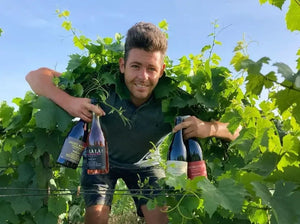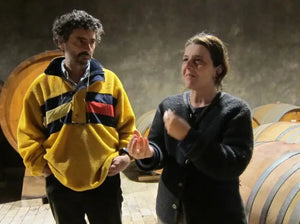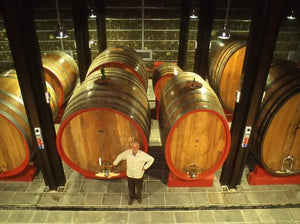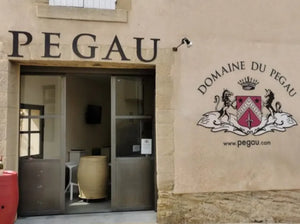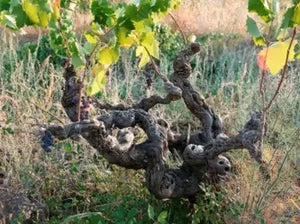Blog » Red
-
Jean-Louis Dutraive: Fleurie's Bright Light
Jean-Louis Dutraive's entire stable of wines falls into the elite category of Cru Beaujolais. While he has various parcels in Fleurie, the Clos de la Grand Cour always thrills me for its lightness and ethereal pitch.
The Clos de la Grand Cour is a true walled-in vineyard, with up to 80-year-old vines growing on almost pure granite with a thin topsoil. The wine ages 35% in stainless steel, 30% in fûts de chêne, and 30% foudres for 9 to 12 months. Lifted spices meet fresh raspberry and cherry to give a delicate wine with a deep texture and a long finish.
The old-vine cuvée, Le Clos, takes the concentration and intensity up with darker red fruits and penetrating salinity. With its deeper soils, the Chapelle des Bois gives a more satiny texture with less incisive minerality. And the Brouilly shows a more muscular side of Dutraive's still charming and approachable form.
Compared to other titans of Beaujolais, I find Dutraive's wines are often lighter in color, with more lifted spice and a wild, natural element that stands out due to a low sulfur protocol. I try to wait several years after release to tap into these top cuvées. Aged Dutraive is pure magic when fruit begins to fall to the background, and exotic spices become more prominent.
The 2022s are a giant success at this address and prove that Jean-Louis is still one of the benchmarks of the Beaujolais.Photo by Ted Vance
-
No Stone Unturned: Jean-Louis Chave in St. Joseph
Since 1481, there have been 16 generations of unbroken lineage at the Chave estate along the Rhone River's towering granite slopes. When we look closely at the birthplace of Syrah, there's no name more respected than that of Jean-Louis Chave.
Saint-Joseph's boundaries have expanded immensely since the appellation gained AOC status in 1956, but Chave's choice parcels still represent the best and most serious terroir. Here, there's an underlying mineral component that provides the backbone to their wines, and it's this definition that allows them to age effortlessly. Examples of Saint Joseph from the late 1990s have floored me with their sense of vivacity, freshness, and regal structure.
Jean-Louis Chave joined his father Gérard in 1992 after completing his studies in enology at UC Davis. Once home, his primary mission was to re-plant the steep slopes of Saint Joseph—the same hillside where the domaine first began, but the vineyards laid fallow since the 19th century when phylloxera decimated them. Jean-Louis knew these treacherously steep hillsides in Saint Joseph could produce a magnificent yet value-conscious alternative to Hermitage.
It's been nearly three decades since these terraces were re-built by hand, and vines were re-planted among traditional échalas stakes. Today, the results are stunning wines that remind us the root of Rhone's success comes from hands-on work and attention to detail, something the Chave family has personified for hundreds of years.Photo Credit: Grand Cru Selections
-
Young gun in Savoie: Nicolas FerrandCurious about alpine red wines? Then, you have to check out the Savoie's native red grape variety, Mondeuse. One of the best examples we’ve encountered comes from the young Nicolas Ferrand. We spread the word to as many of our customers as possible and are down to only a few cases.
Coteau de la Mort ($79) has the depth of Northern Rhône Syrah, with high-toned black cherry, black pepper, and pressed rose petals, though this Mondeuse is also surprisingly juicy and sleek. Ferrand does a semi-carbonic fermentation without any piegeage (pressing of the skins), no fining or filtering, uses minimal sulfur, and ages in larger format barrels.The cuvée's name, hill of death, refers to the ancient hillside vineyards re-planted during Savoie’s renaissance in the 1990s, thanks to early champions, like Michel Grisard of Prieuré St-Christophe, who I've written about in past offers. In 2013, the vineyard fell under the stewardship of Ferrand when starting Domaine des Côtes Rousses.
One of the Savoie’s top crus for Mondeuse, Saint Jean de la Porte has distinct red clay soils (the inspiration behind the domaine name), as well as limestone and moraine. Ferrand has farmed organically from the beginning and utilizes horses and sheep in partnership with his neighbors. He's native to the area, but his family previously farmed cattle, making him a first-generation vigneron.In the last decade, Ferrand's vineyard holdings have increased, and so has the buzz for his wines. Savoie expert and author Wink Lorch says, “Nicolas’s wines should become a staple in every Savoie wine lover’s cellar,” and we fervently agree. Coteau de la Mort is a refreshing take on Savoie history. -
Bitouzet-Prieur: Classicism Holding Steady
We all have regrets. One of mine was passing on Bitouzet-Prieur Volnay and Meursault when I turned on the lights in 2015. A friend once said, “If you’re not embarrassed by choices made in the previous year, then you’re not growing.” The 2020 vintage of this domaine marks my redemption.
With winemaking medals galore filling the home of Vincent Bitouzet back in 1860, the marriage to Annie Prieur after that marked the official start of what is now the most classic domaine in Volnay, along with Lafarge. And the whites from vineyards like Meursault 1er Cru Charmes and Perrières are now another great reminder that value is alive and well in the Côte de Beaune.
I only have a few wines from Bitouzet-Prieur, but they are the best cuvées to me after an extensive tasting with the domaine in Brooklyn last year. The Volnay is destemmed, and pigeage (punchdowns) occur twice per day—a process that has seemingly gone out of fashion in Burgundy of late as many opt for remontage (pumpovers) to bring softer contours and more immediacy to the fruit. But the 2020 Volnay is pure class and is precisely the type of Burgundy I seek out—from the greatest red village of the Côte de Beaune.
The whites see extended lees contact and a maximum of 20% new oak. They pull back on the fruity Chardonnay traits, instead digging deep for a saturating mineral through-line that reminds me of wines common pre-2005 heat. Still bursting with site-specificity and deliciousness, they take my mind back to another time with their soft-spoken spirit. -
Hirsch Quake: A Record-Breaking VintageFor the first time, the iconic Hirsch Vineyards has allocated the release of their flagship San Andreas Fault Pinot Noir ($78). And it's no surprise why. 2021 marks not only the most successful vintage for Sonoma Pinot Noir in the 21st century but also the best-ever bottling of this wine.
Hirsch sits half a mile from the San Andreas Fault line. With 34 vineyard blocks comprising the eponymous cuvée, this signature blend is the ultimate snapshot of place. As David Hirsch notes, the fragmentation is unmatched even by the famously subdivided vineyards of Burgundy’s Côte de Nuits. The result is a wine exploding with fresh red cherry, strawberry, and mint notes that segue into a precise finish with dark chocolate, orange skin, and dusty minerality.Driving the winding road from downtown Sonoma to the property at the far edge of California’s coast is a rite of passage. I was lucky enough to work one ridgeline over at Failla’s Estate Vineyard, and I can tell you, despite the acclaim of the Pinot Noirs, the extreme Sonoma Coast’s rugged terrain remains built for a few. David was the first to plant Pinot Noir here in 1980, and the location remains completely remote.Producing wines of consistent ripeness and grace in a marginal climate like this one is no easy feat, especially when the grapes are known for having formidable tannins. And yet, that is precisely the tall task that daughter Jasmine Hirsch and Consulting Winemaker Michael Cruse have accomplished.
The style has changed throughout the last twenty years since David built a winery and began putting Hirsch Vineyards on his own label. Today, they have opted for 100% de-stemming across the board and about 30% new oak for this particular cuvée. Again, 2021 is the most successful version of Hirsch’s San Andreas Fault Pinot Noir, and in a vintage where the entire lineup has received “perfect” praise. -
The Old Rioja Cellar: Private Selections from WineWiseWinter always marks a dramatic shift in the wines we begin to reach for. Many regions that have largely sat on the bench during the sweltering months have eagerly anticipated their call up to the plate. January also coincides with one of the very most exciting releases of the year––The Rioja Cellar.Hiram Simon's WineWise, the official California importer of Lopez de Heredia, visits private cellars each year in and around Rioja. There, he tastes and acquires aged wines from the deepest and most serious cellars in the region. I gave my order request last year based on his tastings, and today, these pristine Tempranillo-based Rioja gems are in stock and ready to ship.Over the last two years, the highlight of Hiram's selections, for me personally, is in these more relatively modestly priced wines. This is always such a rare opportunity to taste one of the world's most classic and age-worthy regions with simply perfect provenance. As mentioned, these wines have been aged in cellars in and around Rioja since their initial release.Note: Gran Reserva (sp.) is part of a nomenclature implemented in 1982. Before that, the Reserva wines were all non-vintage and denoted as 6º Año, in the case of Tondonia. Any wine called Cosecha is by nature the wine subsequently marketed as Gran Reserva.
Photo Credit: Julia Volk
-
Anything but Ordinaire: Wasenhaus Spatburgunder
The hunt for German Pinot Noir producers who get it is a never-ending pursuit. Much of the point-chasing efforts from estates in Baden (Pinot Noir territory) are overly masked through excessive oak, extraction, and out-of-whack ripeness seemingly intended to elicit oohs and ahs from tasters as if they had finally made that Burgundy-beater. Any German producer intent on outshowing Burgundy would be better suited in another line of work.
Today's afternoon offer is exciting for a couple of different reasons. First, Alexander Götze and Christoph Wolber have spent over a decade working at Burgundian domaines like Leflaive, De Montille, Pierre Morey, and Comte Armand. Secondly, I have fond memories of spending time with Alex during my year-long stint in Beaune. His goal was always to return to Germany and produce Pinot Noir that followed the sensibilities that the Côte d'Or naturally transmitted.
Wasenhaus is Pinot Noir at its most ethereal. For me, the entry-level bottling, Grand Ordinaire, is the highlight of the lineup. The delicacy and levity here brought an up-front drinkability and ease that's undeniably delicious and equally brilliant. No doubt, the duo's experience in Burgundy imparted an important lesson: That great wine is made in the vineyard and raised with a soft touch in the cellar.
Much of the elegance in the Wasenhaus range can be attributed to working with vineyards with a higher content of limestone and sand versus the heavier clay soils that are more common throughout Baden. As you can imagine, those with an eye toward grace above power will choose their sites wisely.
The Spätburgunder ferments with 90% destemmed fruit and 10% whole clusters. Aging takes place in neutral barrel for one year, followed by six months in stainless steel. This switch really benefits the wine as it holds in those more crunchy and bright red berry fruit characteristics. The lingering finish with sweet brown spices and savory tones is persistent, especially given the humble price point.
I'm always up for tasting German Pinot Noir, but I rarely find wines that pull me in like red Burgundy. For Wasenhaus, it's the effortless sensibility and focus on terroir that shines the brightest. -
Fleurie Benchmark: Clos de la RoiletteBy nature, most Gamay-based wines from the Beaujolais are opened within a year of release, but the wines of the Coudert family are best known for their unrivaled complexity and track record for aging.One year, at La Paulée's verticals tasting, 31 tables were filled with the best of Burgundy (Roumier, Lafon, Rousseau, Mugneret-Gibourg, D'Angerville) and one sole Cru Beaujolais (Roilette). Set alongside Burgundy's most elite producers, the tasting was a great reminder that the best of Cru Beaujolais greatly rewards the patient.The story of Roilette's evolution is a fascinating one. The vineyards were historically classified as Moulin-à-Vent, and its owners are proud of that designation. But in the 1920s, districts were re-drawn, and the Fleurie appellation was created. This newfound appellation, which was required to appear on the label, enraged the owner of the Clos de Roilette. Instead of printing Fleurie, he used a photo of his racehorse and refused to sell his wines in France, exporting 100% of his production to neighboring countries.In 1967, ownership changed hands, and this largely untended vineyard went into the thoughtful stewardship of Fernand Coudert. Today, the wines are widely regarded as the benchmark of not only Fleurie but the entire Beaujolais region.The border of Moulin-à-Vent and Fleurie, where the estate sits, is home to clay-dominant vineyards. Whereas most of Beaujolais is on granite, the clay and manganese soils of Roilette give a darker and richer expression of Gamay. Blue and black fruits are abundant in all of the estate's wines.Roilette's Fleurie bottling comes from a parcel of 30-to-45-year-old vines and undergoes the same whole cluster, semi-carbonic fermentation regimen as the estate's Cuvée Tardive and Griffe du Marquis. Stylistically, the Fleurie is open-knit and has a more supple tannin structure, still with the stuffing to age gracefully and develop over the next few years.
-
Inconnu: California Cabernet Game-Changer
There are U.S. trailblazers, and there are game-changers, but you rarely find both under one roof. Laura Brennan Bissell's appropriately named label Inconnu, meaning "unknown," is the 2023 discovery that had me feeling, well, seen.
I generally drink Cabernet Sauvignon from Bordeaux, Santa Cruz Mountains, and Napa/Sonoma. But I only pull those corks when the menu calls for steak or lamb. Simply put, you won't find me watching a David Lynch flick with a glass of Cab––I don't have the interest to imbibe for 2 hours sans food. And that is why Inconnu is as invigorating a game-changer as I've tasted from California in a long time.
Bissell's wines all carry modest alcohol levels (well below what that even means in the regions above), and they have such beautiful balance and finesse that they disappear fast but offer long-lasting joy. They marry the refreshing qualities of a great Cru Beaujolais with the flavor profiles of ripe-not-overripe Cabernet Sauvignon, where black cherries and currants can be found with notes of eucalyptus and mint that make things a lot more exciting––and delicious!
Another thing that makes clear these wines were destined to be KWM mainstays is their origin, coming from the same distributor/importer as Clos Rougeard, COS, Soldera, Roagna, and Duroché, to name a handful). At the portfolio tasting last month, I was taken by how each red, regardless of their modest pricing, stood toe-to-toe with one another. I went back multiple times for tastes and was still hard-pressed to pick a favorite––they were all endowed with the kind of grace and intensity that separates the good from the great.
Do not miss these GREAT California reds that check all the boxes for Old World wine lovers and "New California" enthusiasts. And don't miss the crystalline Chenin Blanc from old vines in Clarksburg! -
Starbright Secret: Piero Busso Barbaresco
The 2016 vintage in Piedmont doesn't need an introduction, but the name Piero Busso might. Among the perfect vintage's success stories, Piero's Barbaresco from the Gallina cru has it all. The famous vineyard from Nieve is likely better known for Bruno Giacosa and Luca Roagna. Still, Piero's expression floored us for its immediacy yet age-worthy structure.
This Gallina is all about perfume and bright aromatics, like the best 2016s show in spades. On the palate, a thrilling concentration of red berries with mint have loads of gripping intensity, and the finish is classic Barbaresco with that more dusty minerality finely woven through, compared to Barolo's broader tannic personality.
A sense of grace and understated elegance jumps out of the glass. When we all tried our first sip in San Diego, we looked at each other and knew the obvious greatness captured in this 2016 rendition. While Piero Busso and his Gallina Barbaresco are always a match made in heaven, this exceptional vintage is drinking beautifully right now with so much upside in the cellar.
-
Designations be Damned: Sylvain Pataille Marsannay
Sylvain Pataille is famous for three things: Producing some of the most texturally seamless and balanced wines in the Côte de Nuits, his oenologist consulting for over 15 domaines, and having really awesome hair. My visit to the domaine was a terroir masterclass, as we tasted over 20 wines from Marsannay.
Marsannay and Pataille are a match made in heaven. Both have seemingly flown under the radar for far too long. Search through any savvy Burgundy collector's cellar, and next to the Rousseau and Dujac, you're sure to find a host of Pataille's Marsannay. This village located above Gevrey Chambertin has a complicated history, though. Mainly planted with Gamay at the time of classifications, no vineyards could receive a status higher than villages.
Today, Clos du Roy would undoubtedly be a Premier Cru, and it's a steal within the hierarchy of Burgundy's elite. There's never shyness here, always finding that elusive mix between power, elegance, and silken tannins without overt new oak influence. And, believe it or not, Le Chaptire's historical pricing in the 16th century was only surpassed by Chambertin-Clos de Beze. It's still among the ultimate insider lieu-dits and an equally worthy cellar mate with Clos du Roy. -
We're Gonna Need a Bigger Boat: Maison Stephan Syrah
We reserve our biggest boats for the most prime catches. Today that means Jean-Michel Stephan's first-time cuvée from Syrah vines planted just outside Côte Rôtie's zone. This 100% Syrah, labeled Vin de France, was the most transcendent find for us in a long time. At $39 per bottle, this wowed us for its Côte Rôtie-like concentration of blackberry fruit, roasted meat notes, with loads of lavender and black pepper––the intensity we're accustomed to finding in bottles well over $75.
Maison Stephan's Syrah comes from just one hectare of vines in Ampuis and Chasse-sur-Rhône. As is the norm here from a Marcel Lapierre disciple, Stephan relies on carbonic and semi-carbonic fermentation with native yeasts and zero additives. Unfiltered and unfined without sulfur. Aging six months in stainless steel means this 2022 harnesses the primary fruit from the sunny growing season and has a fresh streak on the finish that screams granitic minerality.
We see this as an ideal option for holiday feasts with chicken, pork, beef, and lamb, and it will also be brilliantly served with a slight chill once we enter spring and summer 2024. We love Syrah, and this is our value champion of 2023. -
Angela's Ethereal Grenache: A Tribute to GraceSanta Barbara County is producing some of the most thought-provoking and impressive wines in the U.S. If a sense of place is what we're after, Angela Osborne's Grenache-focused label, A Tribute to Grace, is a great place for the exploration to start.
Working closely with Angela during my time at Failla Wines, in 2011, I remember the first time she poured the Santa Barbara Highlands Vineyard Grenache for our crew, and the enthusiasm that followed. With partial whole cluster fermentation and minimal new oak, the wines are light on their feet and showcase all of the delicacy that Grenache is capable of but rarely achieves in California.
Angela grew up in New Zealand, and upon tasting the greatest expression of Grenache in the world, Chateau Rayas, set out to find the perfect terroir to produce a Grenache-focused label. Angela's grandmother, named Grace, was an equally forceful inspiration toward her landing in California. As terrific as these wines are, knowing the kind person crafting them makes the appeal even greater. -
Leaping Over Legacy: Pierre Girardin Bourgogne
Vincent Girardin's name was synonymous with Burgundy's breadth, with wines coming from enviable vineyards throughout the Côte d'Or. Although the vast terroir had undeniable gems from Grand Crus and Premier Crus, the large production made for boring wines. When Vincent sold the domaine in 2011, he kept 4.5 hectares of the top holdings for his son, Pierre. After spending time in the vines, cuverie, and cellar from a very young age, the 21-year-old Pierre wanted to take a different philosophical path with his label. He was determined to be associated with the highest quality work––albeit with much more limited availability.
As the cuvée's label suggests, calcaire (limestone) is what Pierre wants to express, and the lens of terroir is in focus with these terrific Bourgogne wines. Pierre's methods highlight freshness and finesse––a rare move was selecting considerably larger 456L barrels for aging and favoring punchovers (as opposed to punchdowns) for the reds to keep their tannins silken. The value proposition in Burgundy is one that we bring up a lot. No doubt, pricing keeps climbing, but the emergence of new values is always around the corner. Pierre Girardin is a name that delivers in a big way with a relatively low price tag, given the quality and terroir. -
Languedoc's Jewel: Mas de Daumas Gassac
Outside of the iconic Cabernet Sauvignon addresses in Bordeaux, there's one name in France that can go toe to toe with these chateaux: Mas de Daumas Gassac. As always, the provenance of older wines is a critical factor in the quality you'll find in the glass, and I'm thrilled to offer this mint condition collection from Languedoc's star estate.
Mas de Daumas Gassac was established in 1970 when Véronique and Aimé Guibert came across an abandoned farmhouse owned by the Daumas family along the Gassac River in the Herault. Underground water springs and surrounding mountains created a microclimate mirroring Bordeaux's Médoc, so they planted vine material from First Growth chateaux in Bordeaux. The region has an abundance of 100-plus-year-old plantings, with a dry climate favorable for organic viticulture.
Made of 70% Cabernet Sauvignon supplemented with Cabernet Franc, Merlot, Pinot Noir, Tannat, and Malbec, the wines highlight espresso, dark chocolate, cigar box, brambly blackberries, and savory spices. Still, Languedoc's cooling influences and limestone bedrock have long stood out as a beacon for freshness. Alcohol levels have remained modest through stylistic shifts, never taking Bordeaux's cues when things drastically changed in the '80s. -
Barolo's Royal Family: Giuseppe RinaldiRinaldi is a revered traditionalist following family techniques used since the early and mid-1900s. With long macerations on the skins aging in large botti, the results are powerfully deep Baroli met with precision and aromatics that make them incomparable. They offer wild spices, gamey notes, and of course, Nebbiolo's tell-tale tar and roses.The Giuseppe Rinaldi wines first appeared in 1921, though, it was during Beppe's lifetime that the world's attention turned toward Piedmont—Beppe's spirit is more immortalized than the legendary wines he produced. Sadly, he passed away in 2018, but he had several years to see his daughters, Marta and Carlotta, continue to raise the bar.
I visited the Rinaldi cantina just before harvest in 2012. It was nothing short of a privilege to meet the Rinaldi family and taste the wines, including the monumental 2010s still in botti. Finding back-vintage wines is not a common occurrence today, and I was thrilled to work with Rinaldi's US importer, Vinifera Imports, to acquire several older wines directly from the Rinaldi estate. -
Burgundian Bordeaux: Chateau Le Puy
Situated between Pomerol and Saint Emilion on the second-highest point along the Gironde estuary, Chateau Le Puy is a Bordeaux estate rooted in sensibilities more commonly found in Burgundy. The wines' finesse, dead-serious focus, and drinkability are worlds apart from the stylistic norm.
These vines have been farmed free of chemicals since 1610, and today full biodynamic practices are employed, with work done by horse. The estate's plantings include 85% Merlot, 7% Cabernet Franc, 6% Cabernet Sauvignon, and small percentages of Malbec and Carménère on an amalgamation of red clay, silex, and limestone soils.
In addition to working the vines organically and biodynamically, their fermentation and élevage methods are considered uncommon. Infusion and semi-carbonic methods limit the extraction of hard tannins and retain more primary fruit traits, providing soft texture with bright, open-knit fruit out of the gate. And aging in large foudre preserves all of that verve carried into bottle. -
Portuguese Late-Release: Caves São João
Some of our most successful offers to date have been late-winery releases from Portugal and Spain. Our two mainstays are Caves São João in Bairrada, Portugal, as well as Lopez de Heredia in Rioja, Spain. Past offers have highlighted the Poço do Lobo Branco (White) wines, but we’re returning to their tried and true Tinto (Red) wines, with vintages going back to 1983.
Caves São João was established by the Costa brothers in 1920. Today, their family also produces wines under the Porta dos Cavaleiros, Poço do Lobo, and Frei João labels. In their devotion to producing traditional Portuguese wines, these wines fell out of the limelight in the 1990s during the Robert Parker era, but freshness and finesse are in again! Bairrada is a formidably wet, cool region in the dead center of Portugal. The soil is clay and limestone, and the main red grape variety, Baga, produces small berries with thick skins. Incredibly tannic and acid-driven in their youth, these wines blossom to reveal profound finesse and complexity in due time.
Luckily, we don’t have to go through the hassle of cellaring these wines for decades. In 2013, the Costa family opened their cellars and released wines aged on-site from the 1959 to 2000 vintages. No oak is used—all of the wines age in cement tanks for a minimum of 24 months to retain their freshness. Having these aged wines arrive directly in California is a fortune that rarely happens. In fact, Caves San João is the only winery in Portugal (and one of the few in the world) to do this commercially.
Note: We advise against decanting the red wines, but the white begins to hit its stride after about 30 minutes in a decanter. -
Quintessential California Syrah: Piedrasassi
Santa Barbara's cool-climate wines have growingly become one of my obsessions. For me, the most integral name in the array of labels is Sashi Moorman. His Pinot Noir, Chardonnay, and Gamay are among my favorites, but his first label, Piedrasassi, offers downright delicious and complex reflections of Syrah.
Piedrasassi harnesses savory, bright, and superior aromatics while never shying away from the innately luscious qualities that define California Syrah. They nail the roasted meat, violet, and black pepper trifecta at each price point. The P.S. bottling, sourced from a handful of Piedrasassi's single vineyards, is the perfect introduction to their philosophy on cool-climate Syrah, and the vineyard-designate bottlings best exemplify how these wines continually develop in bottle over many years.
Sashi vinifies and ages as naturally as possible, excluding sulfur at fermentation and only utilizing native yeasts. Whole cluster inclusion and aging in larger 500-liter barrels ensure the lively, crushed rock virtues that make Northern Rhone Syrah so unique aren't lost here in Santa Barbara. -
Fleurie Rising: 2021 Yann Bertrand Beaujolais
Cru Beaujolais has been a cornerstone of our selection from the start. While Foillard, Métras, Lapierre, and Dutraive represent the foundation for the greatest value reds in France, the younger generation is now clearly making its mark. Yann may be separated from the aforementioned because of age, but when you line up his wines, it's crystal clear these are commanding interpretations of terroir.
Yann grew up in Fleurie, but after studying commerce in school and traveling through the Alps, he never expected to circle back to become its generation's brightest talent. He found himself working in a wine shop, and surrounded by passionate people, the flames of curiosity were stoked. He spent time working under perhaps the region's most revered names: Yvon Métras and Jean Foillard. Like them, Yann knew that organic farming and traditional methods in the cellar would be his path forward.
In 1992, Yann's family purchased vineyards and slowly converted them to organic farming. Yann took a more active role in leading the domaine in 2013, and he began applying what he had soaked up from his apprenticeships. Similarly, Yann's style is one of elegance, silken texture, and laser focus, expressing each unique terroir in the Famille Bertrand stable. -
Giovanna's Chianti: Le Boncie
When I have the opportunity to prove that Chianti Classico can show grace and pristine fruit quality akin to Red Burgundy, I use Giovanna Morganti's Le Boncie as my first example. I implore you to trust this will be your moment of clarity for Sangiovese.
Importer Neal Rosenthal's Montevertine is a benchmark for the region, but his other discovery, Le Trame, better illustrates Sangiovese's sometimes elusive, fruit-forward profile and silken tannins. Also consider Chiesamonti, which comes from a one-hectare parcel in Castelnuovo Berardenga. The stonier soils here result in a wine with brighter red fruits and a long saline finish (Differing from Giovanna's other wines that exhibit more fleshy characteristics). These two Chiantis are all class.
Giovanna farms her five hectares using organic and biodynamic principles. I could go down the rabbit hole on farming, fermentation, and aging specifics, but I'd like to cut this one short and say: This is a profound wine that's a joy to drink. I've lost count of the number of times I've used this bottling to convince friends that Sangiovese can be fun, approachable, and deadly serious. Below is a photo from my 2017 visit and the gorgeous color of the Stockinger barrel sample that had me in love. -
The Epitome of Montalcino: Gianfranco Soldera
Soldera on the Casse Basse estate is hallowed ground in Montalcino. Founded in 1972 by Gianfranco Soldera, it's still one of Italy's most mysterious and celebrated addresses. Soldera is known for their rigorous standards in the vineyard, and selection in the cuverie is ruthless. The wines are featherweight, age-worthy beyond compare, and a model upon which all others in Montalcino follow suit.
The late Gianfranco was on vacation during my visit in 2017, but touring with his son-in-law, Paolo, who manages production, was a detailed exploration. The estate's 10 hectares of vines are adjacent to a mesmerizing garden with hundreds of flowers. The vineyard's hillside is composed of clay and galestro, a schist rock that can be broken apart in your hands, allowing vines to travel deep below the surface for nutrients. The vines grow freely, modeled after Lalou-Bize Leroy in Burgundy. But the real turn of events with the farming is the shockingly low yields, with some vines reduced to as few as three clusters prior to harvest.
The role of selection became a great theme. Soldera believes each vintage has an optimal berry size. They have a de-stemming machine that disposes of grapes outside the preferred dimensions. These select grapes ferment in massive old wood fermenters and get transferred to botti for elévage. Sulfur additions are essentially zero. After the required two years of aging, the wine goes directly from botti to bottling line, minimizing the movement as much as humanly possible.
Sampling the gorgeous 2013 vintage from botti was a haunting experience. The wine was shockingly transparent and light, beginning with its fabled weightless frame, then a saturating and deep grip. The tannins are never forceful, but that's not to underestimate the aging intended for this wine. Sangiovese takes on so many forms in Montalcino and Chianti, but here at Soldera, it seems to exist on its own plane. There's no doubt in my mind after visiting that this site is truly magical, but it's the difficult choices that are made at every stage that allow a wine of this magnitude to come to life. -
Châteauneuf du Pape CélébritéIn Châteauneuf du Pape, walking the fine line between elegance and rusticity is difficult, but Domaine Pégau embodies the precision of this balance like none other. Their progression over the last ten years to highlight a more lifted style while maintaining a sense of opulence is a hot topic for lovers of the Southern Rhône Valley. While the estate produces several cuvées, their Cuvée Réservée fulfills the best value and sharpest focus on this fabled terroir.
The Reservée has always been the prime CdP for value, but Laurence's recent move to raise the Grenache and lower the Syrah percentage in the blend has done wonders for its clarity and persistence. Licorice, dark fruits, woodsmoke, game, and wild garrigue are hallmarks of every bottle of CdP. Pégau captures these notes with an impressive mineral streak and fine-grained tannins that stand out from the pack. A rack of lamb alongside Pégau has become one of my ultimate pleasures.
Laurence Féraud works with her father, Paul, in carrying on a steep tradition started by their ancestors in 1607. The backbone of the estate is their old Grenache plantings dating back to 1907 in the famed La Crau vineyard, where limestone mother rock sits below the iconic, round galet river stones. They use whole clusters for vinification, and the wines age in large foudres crafted nearly a century ago. Both elements are crucial in preserving a sense of vibrancy in their Grenache-dominant blends.
Truth be told, the Southern Rhône pulled me into France way back when I was finishing college. Today, I pull bottles from this region with much less regularity—much of that has to do with producers chasing after power and points. However, Pégau never succumbed to altering their methods. I can't tell you how refreshing it is to have a select few producers that still makes wines that they love to drink and their ancestors would be proud of today. Pégau is everything sacred about tradition and should be celebrated as often as possible. -
Old-School Mt. Etna: Massimiliano Calabretta
“I make my wine like Bartolo Mascarello!” That's what Massimiliano Calabretta told his U.S. importer when they first visited his estate in Sicily. The family's formula is simple: To work with old-vine and own-rooted parcels preserved as long as possible through organic farming. Their historic practices have stood the test of time as the world around them rapidly changed. The wines at Calebretta are entrenched in tradition, just as Bartolo Mascarello would have approved.
Nerello Cappuccio is often considered a blending grape (mainly because of its viticulture difficulty and susceptibility to disease than any varietal shortcoming). Calabretta saw his old, ungrafted vines offered a very different expression of the variety, with an aromatic lift that stood apart from his counterparts: Dark red fruits, smoke, lavender, violets, and a saline-infused finish that has made reaching for this wine habitual.
Nerello Mascalese is the primary red variety on Mt. Etna. The vines for Calabretta's old-vine cuvée, Vigne Vecchie, start at 60 years old and go well over 100 years, many of which are un-grafted. Aging takes place in 50-70 hectoliter Slavonian casks for up to 42 months. This protocol draws parallels to traditional Barolo producers, but the similarities go beyond aging formats.
.svg?v=162776257677185172071677832259)



